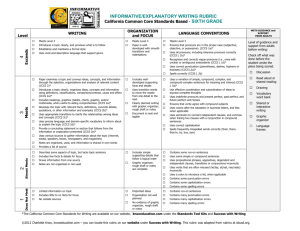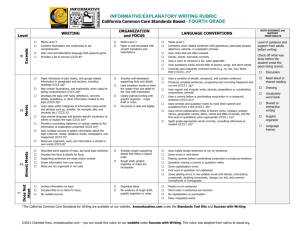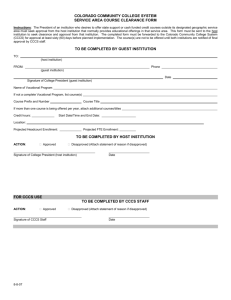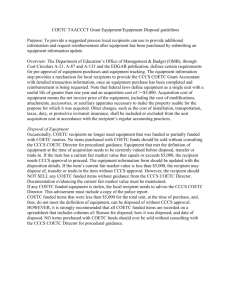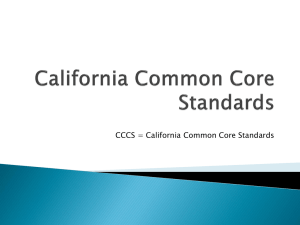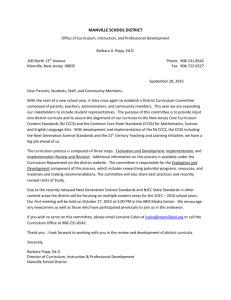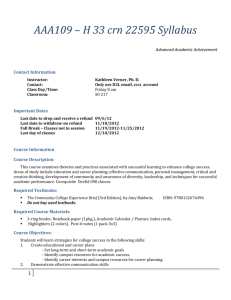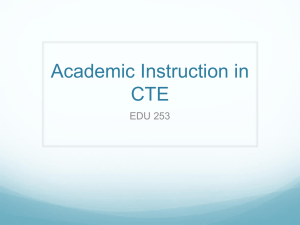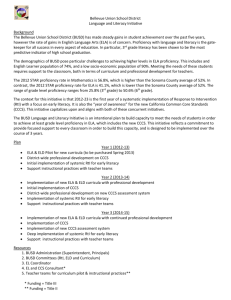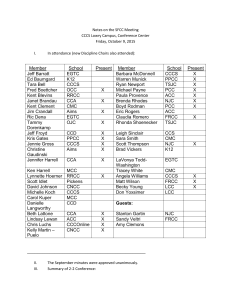Informative Writing Rubric – California Common Core Standards
advertisement
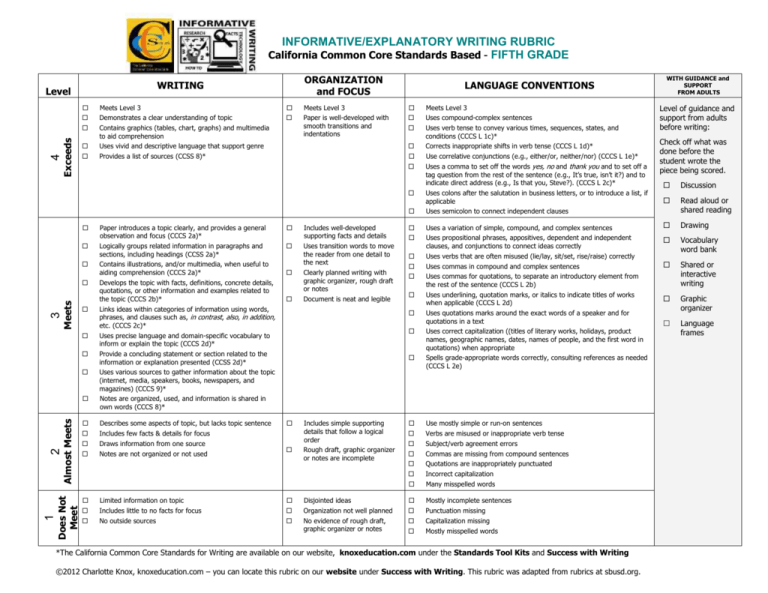
INFORMATIVE/EXPLANATORY WRITING RUBRIC California Common Core Standards Based - FIFTH GRADE Level Meets Level 3 Demonstrates a clear understanding of topic Contains graphics (tables, chart, graphs) and multimedia to aid comprehension Uses vivid and descriptive language that support genre Provides a list of sources (CCSS 8)* 4 Exceeds Includes well-developed supporting facts and details Logically groups related information in paragraphs and sections, including headings (CCSS 2a)* Contains illustrations, and/or multimedia, when useful to aiding comprehension (CCCS 2a)* Uses transition words to move the reader from one detail to the next Meets 3 2 Develops the topic with facts, definitions, concrete details, quotations, or other information and examples related to the topic (CCCS 2b)* Links ideas within categories of information using words, phrases, and clauses such as, in contrast, also, in addition, etc. (CCCS 2c)* Uses precise language and domain-specific vocabulary to inform or explain the topic (CCCS 2d)* Provide a concluding statement or section related to the information or explanation presented (CCSS 2d)* Uses various sources to gather information about the topic (internet, media, speakers, books, newspapers, and magazines) (CCCS 9)* Notes are organized, used, and information is shared in own words (CCCS 8)* Describes some aspects of topic, but lacks topic sentence Includes few facts & details for focus Draws information from one source Notes are not organized or not used LANGUAGE CONVENTIONS Almost Meets Meets Level 3 Paper is well-developed with smooth transitions and indentations Paper introduces a topic clearly, and provides a general observation and focus (CCCS 2a)* 1 Does Not Meet ORGANIZATION and FOCUS WRITING Clearly planned writing with graphic organizer, rough draft or notes Document is neat and legible Use correlative conjunctions (e.g., either/or, neither/nor) (CCCS L 1e)* Uses a comma to set off the words yes, no and thank you and to set off a tag question from the rest of the sentence (e.g., It’s true, isn’t it?) and to indicate direct address (e.g., Is that you, Steve?). (CCCS L 2c)* Uses colons after the salutation in business letters, or to introduce a list, if applicable Uses semicolon to connect independent clauses Includes simple supporting details that follow a logical order Rough draft, graphic organizer or notes are incomplete Level of guidance and support from adults before writing: Check off what was done before the student wrote the piece being scored. Discussion Read aloud or shared reading Uses a variation of simple, compound, and complex sentences Drawing Uses propositional phrases, appositives, dependent and independent clauses, and conjunctions to connect ideas correctly Uses verbs that are often misused (lie/lay, sit/set, rise/raise) correctly Uses commas in compound and complex sentences Uses commas for quotations, to separate an introductory element from the rest of the sentence (CCCS L 2b) Vocabulary word bank Shared or interactive writing Uses underlining, quotation marks, or italics to indicate titles of works when applicable (CCCS L 2d) Uses quotations marks around the exact words of a speaker and for quotations in a text Graphic organizer Uses correct capitalization ((titles of literary works, holidays, product names, geographic names, dates, names of people, and the first word in quotations) when appropriate Spells grade-appropriate words correctly, consulting references as needed (CCCS L 2e) Language frames Meets Level 3 Uses compound-complex sentences Uses verb tense to convey various times, sequences, states, and conditions (CCCS L 1c)* Corrects inappropriate shifts in verb tense (CCCS L 1d)* WITH GUIDANCE and SUPPORT FROM ADULTS Use mostly simple or run-on sentences Verbs are misused or inappropriate verb tense Subject/verb agreement errors Commas are missing from compound sentences Quotations are inappropriately punctuated Incorrect capitalization Many misspelled words Limited information on topic Disjointed ideas Mostly incomplete sentences Includes little to no facts for focus No outside sources Organization not well planned No evidence of rough draft, graphic organizer or notes Punctuation missing Capitalization missing Mostly misspelled words *The California Common Core Standards for Writing are available on our website, knoxeducation.com under the Standards Tool Kits and Success with Writing ©2012 Charlotte Knox, knoxeducation.com – you can locate this rubric on our website under Success with Writing. This rubric was adapted from rubrics at sbusd.org.
